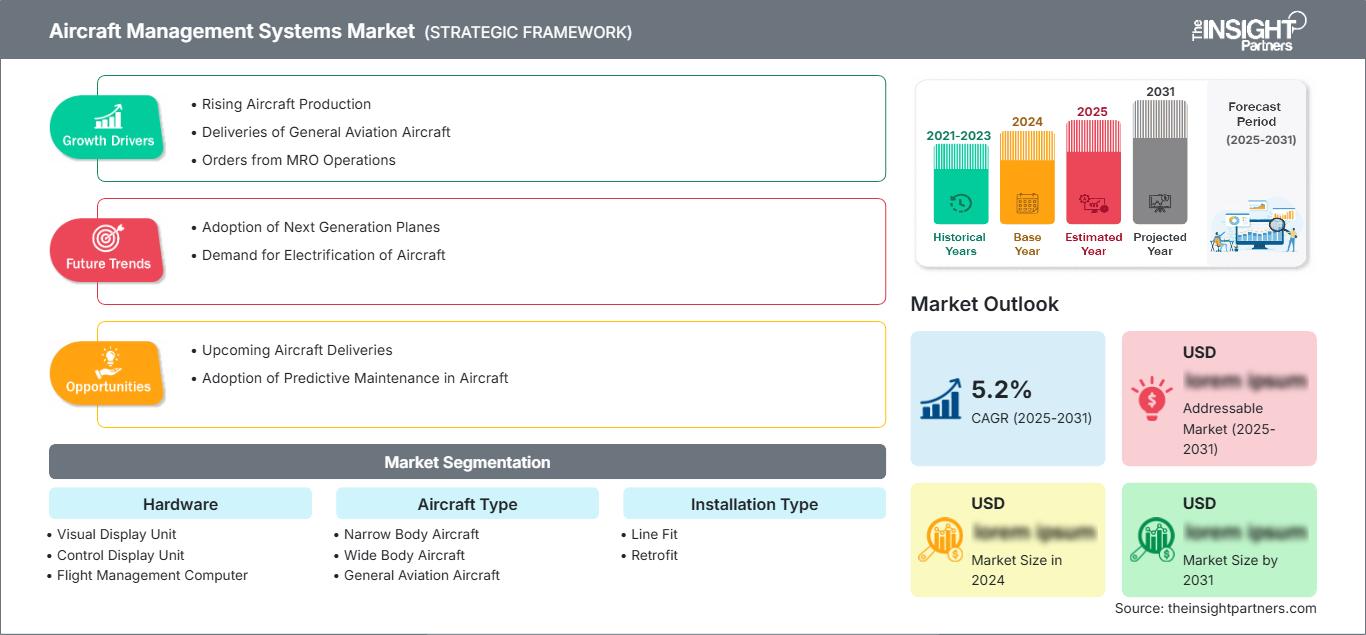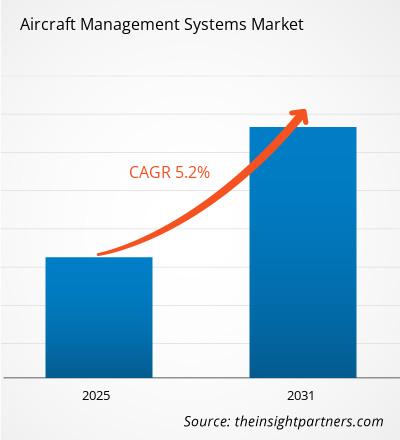Se prevé que el mercado de sistemas de gestión de aeronaves registre una tasa de crecimiento anual compuesta (TCAC) del 5,2% entre 2025 y 2031, con un tamaño de mercado que se expandirá de XX millones de dólares estadounidenses en 2024 a XX millones de dólares estadounidenses en 2031.
El informe se segmenta por hardware (unidad de visualización, unidad de control, ordenador de gestión de vuelo y otros); tipo de aeronave (aeronaves de fuselaje estrecho, aeronaves de fuselaje ancho y aeronaves de aviación general); tipo de instalación (instalación en línea y modernización); y uso final (comercial y militar). El análisis global se desglosa aún más a nivel regional y por países principales. El informe ofrece el valor en USD para el análisis y los segmentos mencionados.
Finalidad del informe
El informe sobre el mercado de sistemas de gestión de aeronaves, elaborado por The Insight Partners, tiene como objetivo describir el panorama actual y el crecimiento futuro, los principales factores impulsores, los desafíos y las oportunidades. Esto proporcionará información valiosa a diversos actores del sector, tales como:
- Proveedores/fabricantes de tecnología: Para comprender la evolución de la dinámica del mercado y conocer las posibles oportunidades de crecimiento, lo que les permitirá tomar decisiones estratégicas informadas.
- Inversores: Realizar un análisis exhaustivo de las tendencias relativas a la tasa de crecimiento del mercado, las proyecciones financieras del mercado y las oportunidades que existen a lo largo de la cadena de valor.
- Organismos reguladores: Regular las políticas y controlar las actividades en el mercado con el objetivo de minimizar los abusos, preservar la confianza de los inversores y mantener la integridad y la estabilidad del mercado.
Segmentación del mercado de sistemas de gestión de aeronaves
Hardware
- Unidad de visualización
- Unidad de visualización de control
- Ordenador de gestión de vuelo
- Otros
Tipo de aeronave
- Aviones de fuselaje estrecho
- Aviones de fuselaje ancho
- Aeronaves de aviación general
Tipo de instalación
- Ajuste de línea
- Reacondicionamiento
Uso final
- Comercial
- Militar
Obtendrá personalización gratuita de cualquier informe, incluyendo partes de este informe, análisis a nivel de país y paquetes de datos de Excel. Además, podrá aprovechar excelentes ofertas y descuentos para empresas emergentes y universidades.
Mercado de sistemas de gestión de aeronaves: Perspectivas estratégicas

-
Obtenga las principales tendencias clave del mercado que se describen en este informe.Esta muestra GRATUITA incluirá análisis de datos, que abarcarán desde tendencias de mercado hasta estimaciones y pronósticos.
Factores que impulsan el crecimiento del mercado de sistemas de gestión de aeronaves
- Aumento de la producción de aeronaves: El incremento de la producción de aeronaves en diferentes regiones está impulsando el crecimiento del mercado de sistemas de gestión de aeronaves.
- Entregas de aeronaves de aviación general: El aumento de las entregas de aeronaves de aviación general es otro factor importante que impulsa el crecimiento del mercado de despliegue de sistemas de gestión de aeronaves.
- Pedidos de operaciones de mantenimiento, reparación y revisión (MRO): El creciente sector del mantenimiento, reparación y revisión (MRO) de aeronaves es otro factor importante que impulsa la adopción de sistemas de gestión de aeronaves a nivel mundial.
Tendencias futuras del mercado de sistemas de gestión de aeronaves
- Adopción de aviones de nueva generación: Impulsando la adopción de sistemas de gestión de aeronaves.
- Demanda de electrificación de aeronaves: La creciente demanda de electrificación en las aeronaves para aumentar la eficiencia general está impulsando la adopción de sistemas de gestión de aeronaves, como diferentes tipos de unidades de control y visualización para plataformas aéreas.
Oportunidades de mercado de sistemas de gestión de aeronaves
- Próximas entregas de aeronaves: Es probable que las entregas previstas de aeronaves comerciales impulsen el mercado de sistemas de gestión de aeronaves en los próximos años.
- Adopción del mantenimiento predictivo en aeronaves: La demanda de mantenimiento predictivo para garantizar operaciones aéreas más seguras es otro factor importante que probablemente generará nuevas oportunidades para los proveedores del mercado en los próximos años.
Perspectivas regionales del mercado de sistemas de gestión de aeronaves
Los analistas de The Insight Partners han explicado en detalle las tendencias y los factores regionales que influyen en el mercado de sistemas de gestión de aeronaves durante el período de previsión. Esta sección también analiza los segmentos y la geografía del mercado de sistemas de gestión de aeronaves en Norteamérica, Europa, Asia Pacífico, Oriente Medio y África, y Sudamérica y Centroamérica.
Alcance del informe de mercado de sistemas de gestión de aeronaves
| Atributo del informe | Detalles |
|---|---|
| Tamaño del mercado en 2024 | XX millones de dólares estadounidenses |
| Tamaño del mercado para 2031 | XX millones de dólares estadounidenses |
| Tasa de crecimiento anual compuesto global (2025 - 2031) | 5,2% |
| Datos históricos | 2021-2023 |
| período de previsión | 2025-2031 |
| Segmentos cubiertos |
Por hardware
|
| Regiones y países cubiertos |
América del norte
|
| Líderes del mercado y perfiles de empresas clave |
|
Densidad de los actores del mercado de sistemas de gestión de aeronaves: comprensión de su impacto en la dinámica empresarial
El mercado de sistemas de gestión de aeronaves está creciendo rápidamente, impulsado por la creciente demanda de los usuarios finales debido a factores como la evolución de las preferencias de los consumidores, los avances tecnológicos y una mayor conciencia de los beneficios del producto. A medida que aumenta la demanda, las empresas amplían su oferta, innovan para satisfacer las necesidades de los consumidores y aprovechan las tendencias emergentes, lo que impulsa aún más el crecimiento del mercado.

- Obtenga una visión general de los principales actores del mercado de sistemas de gestión de aeronaves.
Puntos clave de venta
- Cobertura integral: El informe abarca de forma exhaustiva el análisis de productos, servicios, tipos y usuarios finales del mercado de sistemas de gestión de aeronaves, proporcionando una visión holística.
- Análisis de expertos: El informe se elabora a partir del profundo conocimiento de expertos y analistas del sector.
- Información actualizada: El informe garantiza su relevancia para el negocio gracias a su cobertura de información reciente y tendencias de datos.
- Opciones de personalización: Este informe se puede personalizar para satisfacer las necesidades específicas del cliente y adaptarse adecuadamente a las estrategias comerciales.
Por lo tanto, el informe de investigación sobre el mercado de sistemas de gestión de aeronaves puede ayudar a liderar el proceso de análisis y comprensión del panorama de la industria y sus perspectivas de crecimiento. Si bien existen algunas preocupaciones válidas, los beneficios generales de este informe tienden a superar las desventajas.
- Análisis histórico (2 años), año base, pronóstico (7 años) con CAGR
- Análisis PEST y FODA
- Tamaño del mercado, valor/volumen: global, regional y nacional
- Industria y panorama competitivo
- Conjunto de datos de Excel
Informes recientes
Informes relacionados
Testimonios
Razón para comprar
- Toma de decisiones informada
- Comprensión de la dinámica del mercado
- Análisis competitivo
- Información sobre clientes
- Pronósticos del mercado
- Mitigación de riesgos
- Planificación estratégica
- Justificación de la inversión
- Identificación de mercados emergentes
- Mejora de las estrategias de marketing
- Impulso de la eficiencia operativa
- Alineación con las tendencias regulatorias






















 Obtenga una muestra gratuita para - Mercado de sistemas de gestión de aeronaves
Obtenga una muestra gratuita para - Mercado de sistemas de gestión de aeronaves